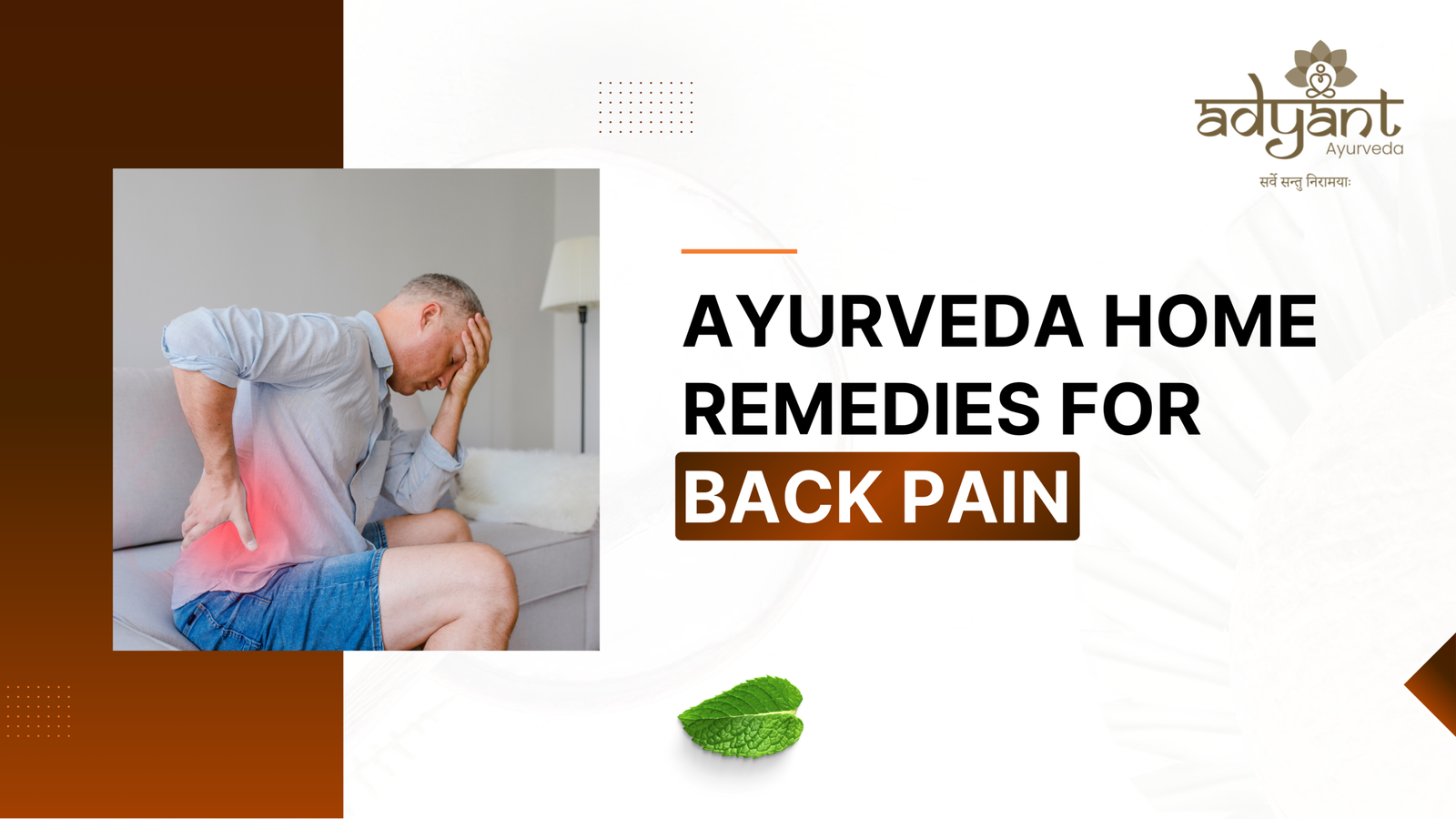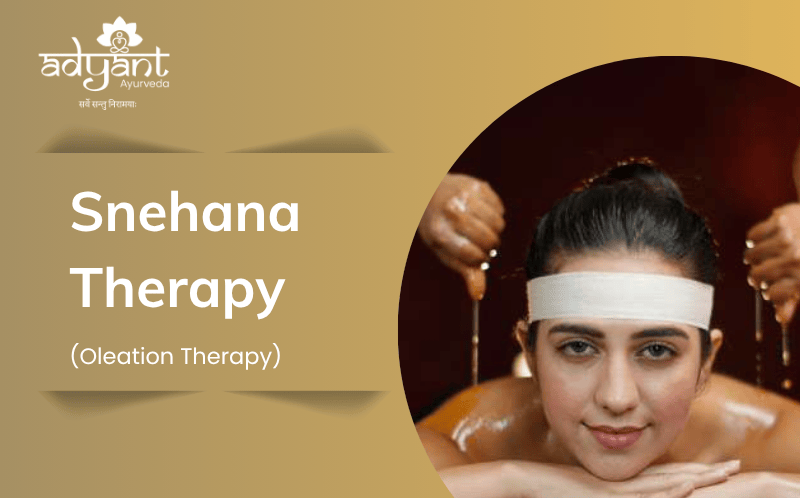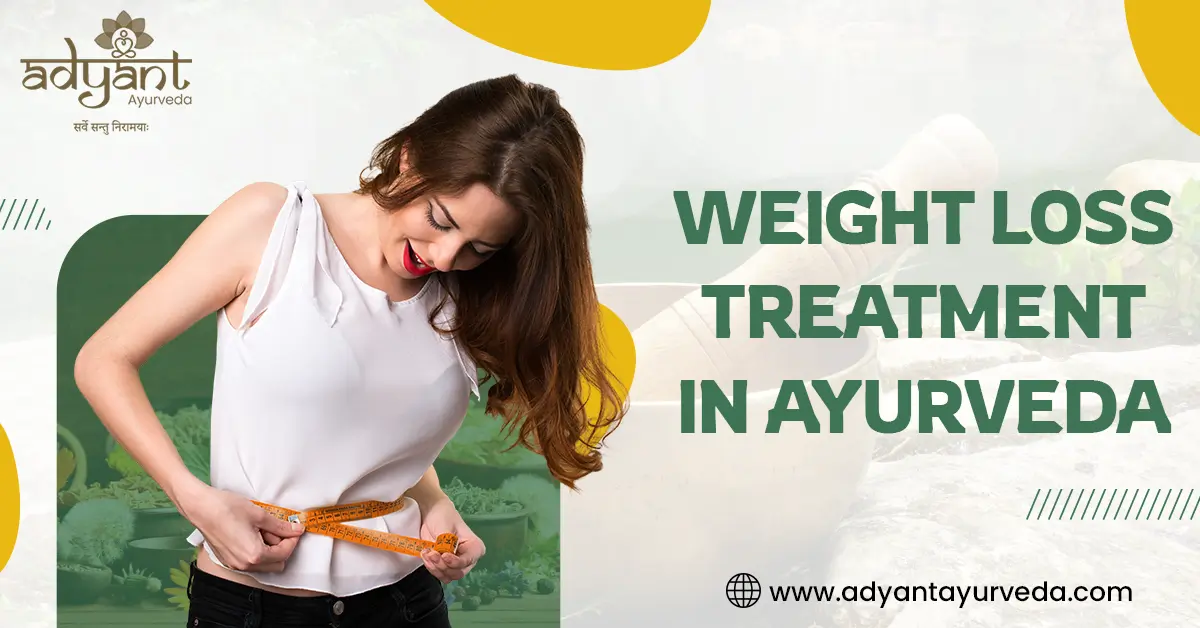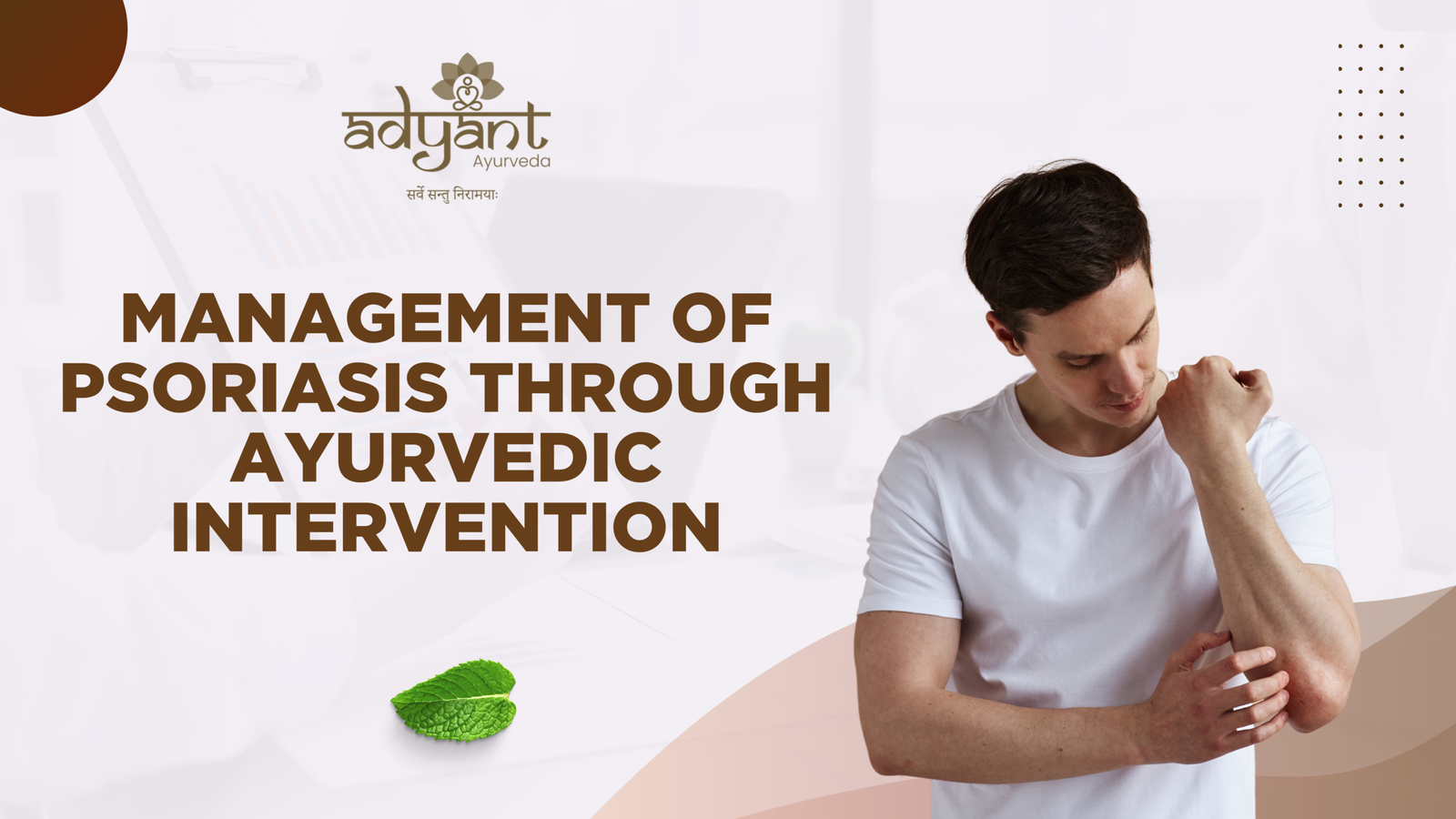Table of Contents
ToggleOsteoarthritis (OA) — the most common form of arthritis — is a degenerative joint disorder often termed the “wear and tear” disease of joints. It results from the breakdown of cartilage, leading to pain, stiffness, and reduced mobility.
Modern medicine primarily focuses on symptom management, while Ayurveda addresses the root cause by restoring the balance of Vata dosha, the primary factor behind degeneration.
If you diagnose Osteoarthritis in its early stages, it can be effectively managed through lifestyle changes, Ayurvedic medications, and Panchakarma therapies. Early intervention not only reduces pain but also prevents long-term disability and cartilage degeneration.
At Adyant Ayurveda, our approach combines authentic Ayurvedic principles, Panchakarma therapies, and lifestyle modifications for sustainable joint health and pain-free living.
“Osteoarthritis is not just a joint problem; it is an imbalance of the body’s doshas, particularly Vata. Through personalized Ayurvedic therapies, Panchakarma, and lifestyle guidance, we can reduce pain, improve joint mobility, and help patients lead an active, pain-free life.”
What is Osteoarthritis?
Osteoarthritis is a chronic degenerative condition that affects the cartilage — the smooth tissue that cushions the ends of bones within a joint. As cartilage deteriorates, bones begin to rub against each other, causing inflammation, stiffness, and pain.
Although it can affect any joint, knees, hips, hands, and spine are most commonly involved. While age is a major factor, causes can include injury, obesity, heredity, or repetitive joint stress.
Types of Osteoarthritis
Primary Osteoarthritis:
Natural wear and tear due to aging without any underlying disease.Secondary Osteoarthritis:
Develops from trauma, obesity, diabetes, or inflammatory disorders.Knee Osteoarthritis:
Leads to stiffness and pain while walking or climbing stairs.Hip Osteoarthritis:
Causes pain during sitting, bending, or daily movements.Spinal Osteoarthritis:
Results in back pain and reduced flexibility.Hand Osteoarthritis:
Affects small joints, causing swelling and deformities.
Understanding the type helps Ayurvedic doctors at Adyant Ayurveda plan an individualized and effective treatment strategy.
Ayurvedic View of Osteoarthritis (Sandhigata Vata)
In Ayurveda, Osteoarthritis is known as Sandhigata Vata, meaning “Vata lodged in the joints.”
The vitiation of Vata dosha combined with Ama accumulation (undigested toxins) leads to joint dryness, stiffness, and pain. The condition progresses gradually — from mild discomfort to severe cartilage degeneration — if untreated.
Samprapti (Pathogenesis) of Osteoarthritis
1. Vata Dosha Imbalance
Aggravation of Vata Dosha is the root cause. It dries up the lubricating Shleshaka Kapha in the joints, causing friction, cracking sounds, and stiffness.
2. Weak Digestion (Agni Dushti)
Impaired digestion produces Ama (metabolic toxins) that circulate through the body and settle in weak joints, leading to inflammation and pain.
3. Channel Obstruction (Srotorodha)
Ama obstructs the Asthivaha Srotas (bone channels), preventing nourishment and promoting degeneration.
4. Inflammatory Phase
As Pitta dosha joins, inflammation increases, leading to redness, warmth, and swelling.
5. Depletion of Shleshaka Kapha
Loss of joint lubrication worsens Vata dominance, causing dryness and reduced cushioning.
6. Bone Tissue Depletion (Dhatu Kshaya)
Asthi Dhatu (bone tissue) weakens due to poor nourishment, resulting in cartilage erosion and pain.
7. Joint Inflammation & Damage (Dosha-Dushya Sammurchhana)
Aggravated Vata localizes in joints, causing inflammation, degeneration, and restricted mobility.
Two Types of Pathogenesis
Age-Related (Tissue Depletion Type): Common in elderly due to natural Vata dominance.
Obesity-Induced (Obstruction Type): Caused by Meda (fat tissue) blocking nutrient flow to joints.
Symptoms of Osteoarthritis
Pain and tenderness in joints
Morning stiffness
Limited range of motion
Swelling and warmth
Crepitus (cracking sound)
Weakness around affected joints
Symptoms often worsen in cold weather or after long inactivity.
Causes and Risk Factors
Major Causes
Aging
Joint injury or trauma
Obesity
Genetic predisposition
Repetitive joint overuse
Risk Factors
Age (especially 50+)
Female gender (post-menopausal)
Family history of arthritis
Sedentary lifestyle
Poor posture and occupational strain
Ayurvedic Diagnosis at Adyant Ayurveda
At Adyant Ayurveda, diagnosis includes:
Prakriti-Vikruti analysis
Nadi Pariksha (pulse diagnosis)
Detailed dietary and lifestyle evaluation
Modern investigations such as X-ray or MRI when needed
This integrative approach ensures an accurate understanding of disease progression and the most suitable line of treatment.
Integrative Approach with Modern Medicine
Adyant Ayurveda integrates Ayurvedic assessment with modern diagnostic tools like X-rays, MRI, and blood tests to understand the stage of cartilage damage. This ensures safe, evidence-based treatment while maintaining the authenticity of Ayurvedic practice. Patients with advanced Osteoarthritis are guided on combining Ayurveda with physiotherapy or orthopaedic care when necessary.
Ayurvedic Treatment for Osteoarthritis
Ayurveda focuses on:
Balancing Vata Dosha
Reducing inflammation
Rejuvenating cartilage and bones
Detoxifying the body (via Panchakarma)
Enhancing mobility and lubrication
Ayurvedic Line of Treatment for Osteoarthritis (Chikitsa Siddhanta) at Adyant Ayrveda
According to Ayurveda, the management of Sandhigata Vata involves three main principles:
Shodhana (Purification): Panchakarma therapies like Basti and Virechana to remove Ama and balance doshas.
Shamana (Pacification): Use of anti-inflammatory and rejuvenating herbs like Guggulu, Shallaki, and Ashwagandha.
Rasayana (Rejuvenation): Strengthening bone and cartilage through medicated ghee, milk, and specific herbal formulations.
This holistic line of treatment helps restore joint function, lubricate tissues, and slow down degeneration naturally.
Core Therapies at Adyant Ayurveda
Virechana (Purgation): Eliminates toxins and restores dosha balance.
Anuvasana Basti: Nourishes with medicated oils.
Niruha Basti: Cleanses toxins using herbal decoctions.
External Therapies
Janu Basti: Retaining warm medicated oil over knee joints for pain relief and lubrication.
Patra Pinda Sweda: Herbal bolus fomentation to improve mobility.
Janu Dhara & Janu Pichu: Continuous pouring or cotton pad application of oils for pain relief.
Abhyanga (Oil Massage)
Improves circulation, nourishes tissues, and reduces Vata aggravation.Swedana (Herbal Steam Therapy)
Relieves stiffness and promotes flexibility.
“Janu Basti and Matra Basti are transformative for knee osteoarthritis, reducing pain and restoring mobility naturally.”
— Dr. Shree Lakshmi, BAMS, Senior Ayurvedic Physician
Best Ayurvedic Medicines for Osteoarthritis
Ayurveda offers a wide range of potent herbs and classical formulations that help relieve pain, reduce inflammation, and strengthen joints naturally. These herbs not only provide symptomatic relief but also address the root cause of Osteoarthritis (Sandhigata Vata) by balancing aggravated Vata dosha, reducing Ama (toxins), and nourishing Asthi dhatu (bone tissue).
| Herb / Medicine | Key Benefits |
|---|---|
| Boswellia (Shallaki) | Possesses strong anti-inflammatory properties; helps reduce joint pain, swelling, and stiffness; protects cartilage from degradation. |
| Guggulu (Commiphora mukul) | Detoxifies the joints, reduces inflammation, and improves mobility; supports healthy metabolism of bone and tissue. |
| Ashwagandha (Withania somnifera) | Strengthens muscles and joints; reduces stiffness, stress, and fatigue; improves overall flexibility and bone health. |
| Turmeric (Curcumin / Haridra) | A natural anti-inflammatory and antioxidant; helps in reducing joint pain and oxidative damage in cartilage. |
| Yograj Guggulu | A classical Ayurvedic formulation known for pacifying Vata dosha; reduces joint pain, inflammation, and stiffness while improving strength and flexibility. |
| Maharasnadi Kwath / Kashayam | Traditionally used for chronic joint disorders; alleviates pain and improves circulation around affected joints. |
| Dashmool (Combination of 10 Roots) | Acts as an excellent Vata pacifier; reduces inflammation, relieves pain, and supports tissue regeneration. |
| Rasnadi Churna | Used externally for reducing inflammation and pain in affected joints; often applied before fomentation (Swedana). |
| Lakshadi Guggulu | Strengthens bones, accelerates healing of degenerative joint tissues, and supports healthy bone metabolism. |
| Sukumar Ghrita | Nourishes tissues, reduces Vata imbalance, and improves lubrication within joints; beneficial for chronic joint dryness and stiffness. |
| Shankhapushpi | Supports nerve and joint coordination; reduces stress and muscular tension that often aggravate Vata imbalance. |
| Nirgundi (Vitex negundo) | A natural analgesic and anti-inflammatory herb; reduces swelling and enhances joint mobility. |
All Ayurvedic medicines are prescribed based on individual Prakriti (body constitution), disease stage, and associated dosha imbalance. Therefore, it is essential to consult a qualified Ayurvedic physician before starting any medication.
Ayurvedic Diet for Osteoarthritis
Eat warm, cooked, easy-to-digest meals.
Include ghee, turmeric, and ginger in daily meals.
Avoid cold, dry, processed foods and carbonated drinks.
Stay hydrated with warm water.
Maintain a healthy body weight through light walks and yoga.
Lifestyle Tips & Prevention (Dinacharya)
Daily Abhyanga: Massage with sesame oil.
Yoga: Vajrasana, Trikonasana, and gentle stretching.
Pranayama: Anulom Vilom and Bhramari for stress relief.
Adequate Rest: Avoid overexertion and exposure to cold winds.
Case Study: Successful OA Management at Adyant Ayurveda
A 52-year-old male with left knee osteoarthritis (meniscal tear) experienced 60% relief after 11 days of Taila Dhara with Murivenna and Matra Basti using Guggulu Tiktaka Ghrita.
After a second 7-day course, pain and swelling subsided completely, and joint flexibility improved remarkably.
Why Choose Adyant Ayurveda for Osteoarthritis Treatment?
🌿 Over 28 years of Ayurvedic expertise
🌿 Experienced doctors: Dr. Shree Lakshmi, Dr. Vidya, Dr. Apoorva, Dr. Sumana, Dr. Preethi, Dr. Bhagyalakshmi
🌿 Authentic Panchakarma therapies using GMP-certified oils
🌿 Customized diet and herbal formulations
🌿 5 branches across Bangalore — Jayanagar, Indiranagar, Kalyan Nagar, Rajarajeshwari Nagar, and Bannerghatta Road
📞 Call 9972541009 or📱 Download our app “AyurCare” from Play Store for a free consultation.
Conclusion
Ayurveda offers a sustainable, root-cause-based approach for Osteoarthritis by balancing doshas, rejuvenating joints, and restoring mobility naturally.
Results vary per individual, but with consistent treatment and proper lifestyle, pain-free movement is achievable.
Author & Medical Reviewer
Reviewed by:
Dr. Shree Lakshmi, BAMS – Senior Ayurvedic Physician
Specialist in Panchakarma and joint disorders with over 28 years of experience at Adyant Ayurveda, Jayanagar, Bangalore.
Disclaimer
The information provided is for educational purposes only and should not replace professional medical advice. Ayurvedic treatments aim to support the body’s natural healing and may vary in results for each individual.
Always consult a certified Ayurvedic doctor before starting any treatment or herbal medicine.
All treatments at Adyant Ayurveda are performed by qualified BAMS doctors using authentic Ayurvedic formulations and safe, clinically tested procedures.
FAQs: Ayurveda Treatment for Osteoarthritis
Ans. While Ayurveda may not claim to cure Osteoarthritis entirely, it can significantly reduce pain, and inflammation, and improve joint mobility. Ayurvedic treatments aim to slow down the progression of the disease and enhance the overall quality of life.
Ans. Ayurveda is an ancient Indian system of medicine that uses herbs, diet, and lifestyle changes to help the body heal itself. One of the most effective Ayurvedic remedies for osteoarthritis is turmeric, which has powerful anti-inflammatory properties. Adding turmeric to your diet or taking a supplement can help reduce pain and inflammation associated with osteoarthritis. Other Ayurvedic remedies for osteoarthritis may include ginger, ashwagandha, and Boswellia.
Ans. One of the most effective herbs for treating Osteoarthritis is Turmeric, also known as Curcuma longa. The active ingredient present in turmeric is a polyphenol called curcumin, which is known for its anti-inflammatory and antioxidant properties.
Turmeric has been used for centuries in Ayurveda to treat various inflammatory conditions, including Osteoarthritis. It not only reduces inflammation and pain but also helps in preventing the progression of the disease by inhibiting the breakdown of cartilage. Consuming turmeric in the form of supplements or incorporating it into your daily diet can help alleviate the symptoms of Osteoarthritis and improve mobility.
Ans. In Ayurveda, osteoarthritis is considered a result of an imbalance of the Vata Dosha in the body, which causes inflammation and pain in the joints. According to Ayurveda, the key to reversing osteoarthritis is to restore balance in the Vata Dosha. This can be achieved by following a healthy diet that includes anti-inflammatory foods, practicing yoga and meditation to reduce stress, and using specific herbs and supplements to support joint health.
Ayurvedic treatments such as Panchakarma, Janu basti, Sneha basti, Kashya basti and Abhyanga massage can also be helpful in reducing inflammation and restoring balance in the body.
Ans. Here are some dietary recommendations from Ayurveda that can help manage arthritis symptoms:
- Eat warm, cooked foods: In Ayurveda, it is believed that warm, cooked foods are easier to digest and absorb than cold, raw foods. Therefore, it is recommended to eat warm, cooked meals such as soups, stews, and casseroles.
- Avoid processed and refined foods: Processed and refined foods, such as white bread, sugary snacks, and fast food, can increase inflammation in the body and worsen arthritis symptoms. It is recommended to avoid these foods and instead opt for whole, unprocessed foods.
- Include anti-inflammatory foods in your diet: Foods that have anti-inflammatory properties can help reduce inflammation and pain associated with arthritis. Examples of anti-inflammatory foods include turmeric, ginger, garlic, leafy greens, and fatty fish.
- Eat a variety of fruits and vegetables: Fruits and vegetables are rich in antioxidants, vitamins, and minerals that can help improve overall health and reduce inflammation. It is recommended to eat a variety of colorful fruits and vegetables to get a range of nutrients.
- Avoid dairy and red meat: In Ayurveda, it is believed that dairy and red meat can increase inflammation and aggravate arthritis symptoms. Therefore, it is recommended to avoid or limit these foods.
- Stay hydrated: Drinking enough water is essential for joint health and can help reduce inflammation. It is recommended to drink at least eight glasses of water per day.
Ans. Osteoarthritis is a degenerative joint disease that commonly affects older adults. While there is no known cure for osteoarthritis, there are some natural ways to help slow down the progression of the disease:
- Exercise: Low-impact exercise, such as walking, cycling, and swimming, can help to strengthen the muscles surrounding the joints and reduce the pressure on them
- Maintain a healthy weight
- Eat a balanced diet: Add anti-inflammatory properties, such as turmeric, ginger, and omega-3 fatty acids, can also be beneficial.
- Manage stress levels and take sufficient sleep
Ans. In Ayurveda, osteoarthritis is known as “Sandhivata”. “Sandhi” means joint, and “Vata” refers to the Vata dosha, one of the three doshas or energies that are believed to govern the body according to Ayurvedic principles. Sandhivata is considered a Vata disorder, which means it is characterized by pain, stiffness, and inflammation in the joints
Which vitamins are good for osteoarthritis?
There are several vitamins and minerals that may be beneficial for people with osteoarthritis
Vitamin D: Vitamin D helps to maintain bone health and may also have anti-inflammatory properties.
Vitamin C: Vitamin C is an antioxidant that helps to protect against damage caused by free radicals, which can contribute to inflammation in the body.
Vitamin E: Vitamin E is another antioxidant that may help to reduce inflammation and protect against joint damage.
Calcium: Calcium is important for maintaining strong bones.
Magnesium: Magnesium is important for bone health and may also have anti-inflammatory properties.
Ans. According to Ayurveda, there are several herbs and natural remedies that can help to reduce inflammation, improve joint mobility, and support overall joint health. Cartilage is a type of connective tissue that does not have its own blood supply, which makes it difficult to repair or regenerate once it has been damaged.
Which is the best Ayurvedic treatment for knee arthritis?
Ayurveda offers various treatments for knee arthritis, which can help to reduce pain, inflammation, and stiffness in the knees. The best Ayurvedic treatment for knee arthritis may depend on the individual’s specific symptoms, underlying causes, and overall health. Here are some Ayurvedic treatments that may be beneficial for knee arthritis:
- Panchakarma: Panchakarma is a cleansing and detoxifying treatment that aims to remove toxins from the body and balance the doshas (energies) in the body. Panchakarma may include treatments such as Abhyanga (oil massage), Swedana (herbal steam therapy), and Virechana (purgation therapy), which may help to reduce inflammation and improve joint mobility.
- Basti: Basti is an Ayurvedic treatment that involves administering medicated oils or decoctions through the rectum to help balance the doshas and reduce inflammation. Basti may be beneficial for knee arthritis by reducing pain and stiffness in the knees.
- Herbal remedies: Ayurvedic herbs such as Ashwagandha, Guggulu, Turmeric, Ginger, and Boswellia may help to reduce inflammation and improve joint mobility in the knees. These herbs can be taken internally or applied topically as a paste or oil.
- Dietary changes: Following an Ayurvedic diet that is tailored to your dosha type may help to reduce inflammation and improve joint health. Foods that are rich in anti-inflammatory compounds, such as omega-3 fatty acids, may be particularly beneficial for knee arthritis.
- Lifestyle modifications: Making lifestyle modifications, such as getting regular exercise, practicing yoga or meditation, and managing stress, may also help to reduce inflammation and improve joint health.
Ans. For the Osteoarthritis treatment, Ayurveda focuses on identifying the root cause of the condition and aims to bring balance to the doshas (Vata, Pitta, and Kapha) in the body. It employs a personalized approach to treatment, considering an individual’s unique constitution (Prakriti) and specific imbalances. In contrast, modern medicine often targets symptom management through medications, physical therapy, or surgical interventions.
Ans. Yes, Ayurveda recommends specific dietary guidelines to manage Osteoarthritis. It suggests consuming warm, freshly cooked, and easily digestible foods. Including ghee, turmeric, ginger, and anti-inflammatory spices in the diet can be beneficial. Avoiding cold, heavy, and processed foods is also advised.
Ans. Ayurveda is generally considered safe for most individuals. However, it is essential to consult a qualified Ayurvedic practitioner before starting any treatments, especially if the person has underlying health conditions or is taking other medications.
Ans. Yes, Ayurvedic treatments can be complementary to modern medical interventions. It is essential to inform both Ayurvedic practitioners and conventional healthcare providers about the treatments being pursued to ensure a comprehensive and integrated approach to care.
Ans. Ayurveda Treatment for Osteoarthritis includes Panchakarma therapy (detoxification), Janu Basti (medicated oil treatment for knees), Kati Basti (medicated oil treatment for the lower back), Patra Pinda Sweda (herbal bolus massage), Virechana (purification therapy). These therapies help reduce inflammation, improve joint lubrication, and alleviate pain.








